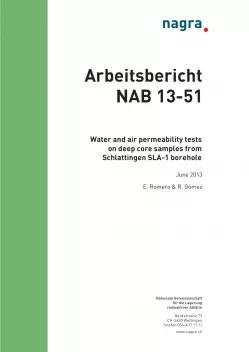
Arbeitsbericht NAB 13-51
Water and air permeability tests on deep core samples from Schlattingen SLA-1 borehole
The Department of Geotechnical Engineering and Geosciences of the Universitat Politècnica de Catalunya in Barcelona (UPC) was requested by NAGRA to perform a geomechanical testing program on two core samples extracted from a deep geothermal well near the village of Schlattingen in the Molasse Basin of Northern Switzerland. The laboratory studies are aimed at characterising the fluid and gas transport behavior of two candidate host rock formations for the disposal of radioactive waste, namely the so-called 'Brown Dogger' (stratigraphic sequence of Callovian, Bathonian and Bajocian age) and the Opalinus Clay. The investigation programme comprises basic geotechnical identification tests, determination of the water retention behaviour and water / gas permeability tests in a triaxial cell. The results of the laboratory investigations will feed in Nagra’s data base on gas related host rock properties. The electronic data base is enclosed in Appendix A.
The initial characterisation program included the definition of the initial state of the tested materials (water content, dry density, density of solids, initial suction, and pore size density function with mercury intrusion porosimetry MIP / nitrogen adsorption). The first stage of the program was intended to provide quantitative data to calibrate hydraulic and two-phase flow properties through MIP (pore size distribution assimilated to water retention curve), water retention tests (psychrometer measurements), as well as water permeability tests at different (effective) stress states and hydraulic gradients that allowed accounting for the change in permeability with void ratio. The different stress states were attained after isotropic compression under controlled confining stress rate and specified water back-pressure. These tests also allowed determining compressibility on loading/unloading of the intact material. The main stage of the program was devoted to study the influence of the stress state under isotropic conditions on the air permeability of initially water saturated samples. Four controlled-volume rate air injection experiments were performed in a triaxial cell by testing two different rock samples under two isotropic stress states (flow was always orthogonal to bedding planes). Two different maximum air injection pressures were attained at high and constant air injection rate (100 mL/min) before shut-in and air dissipation. The maximum air injection pressures were in one case below the air-entry value determined by MIP and around the air-entry value in the second case. Particular emphasis was placed in monitoring sample volume changes (axial strains) during air injection and dissipation stages. Tests were performed during July 2011 and July 2012.
The present report includes the following information for each rock type:
- Documentation of sample and synthetic pore water preparations, experimental set-up and detailed water and air test protocols followed.
- Definition of the initial sate (water content, dry density, density of solids and initial suction), as well as mercury intrusion porosimetry / nitrogen adsorption tests and water retention results (psychrometer measurements during main drying starting from initial conditions).
- Controlled stress rate isotropic compression results under controlled water pressure and their corresponding compressibility.
- Water permeability determined at four different stress states (total stresses of 10, 11.75, 13.25 and 15 MPa), which will be used to assess the void ratio dependence on water permeability. Constant backpressure conditions (downstream between 0.5 and 2 MPa and upstream between 2 and 8.5 MPa) were used to determine water permeability under steady state conditions and flow orthogonal to bedding planes.
- Air permeability results at two different maximum air injection pressures (below the air-entry value determined by MIP at a maximum air pressure of 14 MPa and around the air-entry value at 18 MPa). Time evolution of upstream and downstream pressures, as well as outflow volume and sample volume changes, during the injection and dissipation stages. There was no post-mortem sample characterisation after finishing the air tests.
